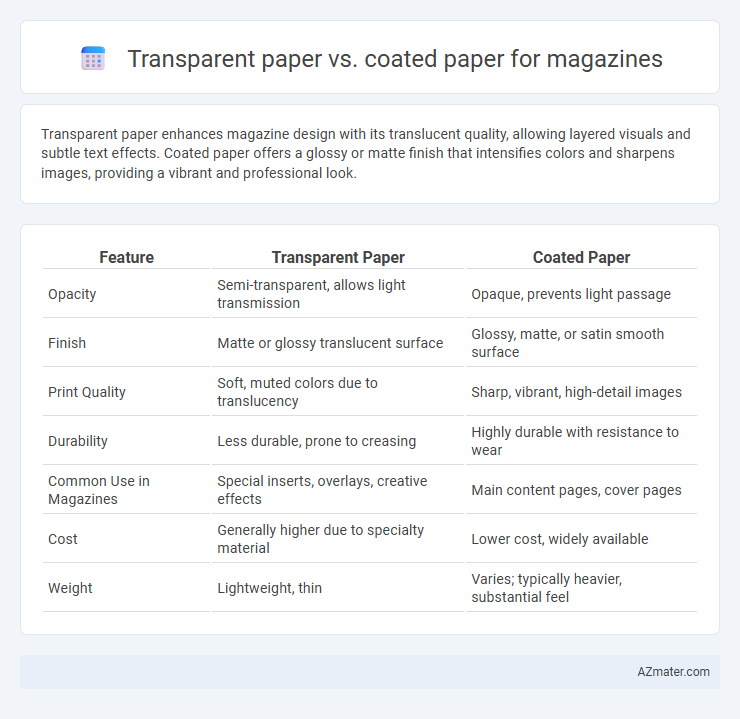Transparent paper enhances magazine design with its translucent quality, allowing layered visuals and subtle text effects. Coated paper offers a glossy or matte finish that intensifies colors and sharpens images, providing a vibrant and professional look.
Table of Comparison
| Feature | Transparent Paper | Coated Paper |
|---|---|---|
| Opacity | Semi-transparent, allows light transmission | Opaque, prevents light passage |
| Finish | Matte or glossy translucent surface | Glossy, matte, or satin smooth surface |
| Print Quality | Soft, muted colors due to translucency | Sharp, vibrant, high-detail images |
| Durability | Less durable, prone to creasing | Highly durable with resistance to wear |
| Common Use in Magazines | Special inserts, overlays, creative effects | Main content pages, cover pages |
| Cost | Generally higher due to specialty material | Lower cost, widely available |
| Weight | Lightweight, thin | Varies; typically heavier, substantial feel |
Introduction to Transparent and Coated Papers
Transparent paper offers durability and a unique translucent aesthetic ideal for innovative magazine designs, while coated paper provides a smooth, glossy surface that enhances image sharpness and color vibrancy. Transparent paper, often made from vellum or synthetic fibers, allows for layered visual effects and creative overlay techniques, making it a favorite for special editions. Coated paper varieties, including gloss, matte, and satin finishes, deliver superior ink holdout and contrast, ensuring high-quality photo reproduction essential for mainstream magazine printing.
Composition and Manufacturing Processes
Transparent paper for magazines is typically made from high-purity cellulose fibers that undergo an extensive bleaching and refining process to achieve translucency, with minimal fillers and additives to maintain clarity. Coated paper is produced by applying a surface layer of pigments such as clay, calcium carbonate, or titanium dioxide, bound by synthetic or natural binders, onto a base paper, enhancing smoothness and print quality. Manufacturing transparent paper requires controlled fiber alignment and pressing techniques to minimize opacity, while coated paper involves sophisticated coating machines and drying systems to ensure uniform pigment distribution and surface texture.
Transparency vs Opacity: Visual Effects
Transparent paper creates a unique visual effect in magazines by allowing underlying images and text to subtly show through, enhancing layering and depth perception. In contrast, coated paper offers high opacity with a smooth, glossy or matte finish that vividly displays colors and sharp details without any bleed-through. Choosing between transparency and opacity directly influences the magazine's aesthetic impact, with transparent paper emphasizing ethereal, multi-dimensional designs and coated paper delivering bold, vibrant visuals.
Print Quality and Color Reproduction
Transparent paper offers a unique translucency that can create distinctive layering effects but may compromise print clarity and sharpness compared to coated paper. Coated paper features a smooth, reflective surface that enhances print quality by providing higher color saturation, sharper images, and more vibrant color reproduction essential for magazines. The ink absorption on coated paper is controlled, preventing bleeding and ensuring precise detail retention, which is critical for high-quality magazine visuals.
Durability and Handling
Transparent paper offers superior durability due to its resistance to tearing and moisture absorption, making it ideal for long-lasting inserts or overlays in magazines. Coated paper, often treated with a glossy or matte finish, enhances color vibrancy but is more susceptible to scratches and fingerprints, impacting handling quality. Selecting transparent paper ensures better longevity and easier handling, especially for pages that require repeated use or manipulation.
Cost Comparison: Transparent vs Coated Paper
Transparent paper generally costs more than coated paper due to its specialized manufacturing process and unique material properties, impacting overall magazine production budgets. Coated paper offers a more economical option with a smooth surface that enhances print quality while maintaining cost-efficiency for high-volume printing. Magazine publishers must weigh the premium pricing of transparent paper against the affordability and proven print performance of coated paper to optimize production expenses.
Environmental Impact and Sustainability
Transparent paper offers a significant environmental advantage due to its production from renewable resources, reduced chemical usage, and recyclability, which collectively lower its carbon footprint in magazine printing. Coated paper, often treated with petroleum-based chemicals and coatings, presents challenges in recycling and contributes to higher environmental pollution and resource depletion. Choosing transparent paper supports sustainable publishing by decreasing landfill waste and promoting eco-friendly material cycles in the magazine industry.
Reader Experience and Aesthetics
Transparent paper in magazines enhances reader experience by allowing layered visuals and text to interact, creating depth and intrigue, while offering a unique tactile sensation that complements high-end aesthetics. Coated paper, with its smooth, glossy finish, delivers vibrant colors and sharp images, ensuring clarity and brightness that attract and maintain reader attention. Both options influence magazine design choices, where transparent paper appeals to artistry and sophistication, and coated paper prioritizes vividness and readability.
Popular Magazine Uses and Case Studies
Transparent paper enhances magazine layouts by offering a unique tactile experience and creative layering effects, frequently used in fashion and art publications to emphasize visual storytelling. Coated paper, with its smooth finish and high ink absorption, dominates popular magazines like National Geographic and Vogue, ensuring vibrant colors and sharp images critical for high-quality photo spreads. Case studies reveal magazines leveraging transparent paper to differentiate limited editions while mainstream publications prefer coated paper for standard issues due to durability and print clarity.
Choosing the Right Paper for Your Publication
Choosing the right paper for your magazine impacts print quality and reader experience; transparent paper offers a unique, translucent aesthetic ideal for layering effects and creative layouts, while coated paper provides a smooth, glossy finish that enhances color vibrancy and sharpness. Transparent paper is best for niche, artistic publications requiring light diffusion and visual intrigue, whereas coated paper suits mainstream magazines demanding durability and vivid image reproduction. Assess your magazine's design goals, printing budget, and target audience preferences to determine the most effective paper choice for your publication.

Infographic: Transparent paper vs Coated paper for Magazine
 azmater.com
azmater.com